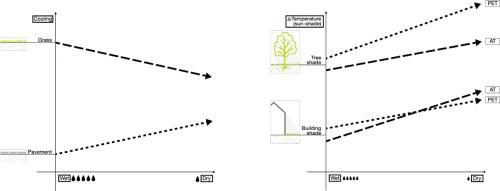Urban Forestry & Urban Greening ( IF 6.0 ) Pub Date : 2021-06-14 , DOI: 10.1016/j.ufug.2021.127223 Mohammad A. Rahman , Vjosa Dervishi , Astrid Moser-Reischl , Ferdinand Ludwig , Hans Pretzsch , Thomas Rötzer , Stephan Pauleit

|
Urban greenspaces showed the potential to lessen the urban heat island effect. However, a detailed understanding on the mechanisms of different components of greenspaces such as grass surfaces, trees or a combination of grey and green infrastructure on reducing heat loads at local and city scale and different weather conditions is still limited. We designed a small-scale experiment within the sub-urban area Freising, close to Munich in Germany during hot summer days of the year 2020 including wet and dry spells. We investigated surface energy balance and the human thermal comfort measured in terms of physiological equivalent temperature (PET). Six sites including grass lawns and paved surfaces, with or without the shade of trees and buildings were selected. Significant positive relationships between surface (ST) and air temperature (AT) were detected both for grass and paved surfaces; however, the relationships were stronger during the wet spells compared to dry spells and for grass surfaces compared to paved surfaces. Moreover, PET was more strongly related to ST compared to AT. Overall, shade reduced 15 °C, 2 °C and 13 °C of ST, AT and PET respectively compared to sunny sites. The differences between sun and shade were steeper over the grass surfaces and during the wet spells when the grass surfaces lost more than 1.5 L m−2 d−1 of water. In contrast, sensible heat fluxes between grass and paved surfaces were not different during the dry spells. Moreover, compared to the building shade, tree shade further reduced AT by 0.6 °C and 0.4 °C during wet and dry spells, but PET by 1 °C and 1.6 °C during wet and dry spells respectively. Our results underline the importance of both shade and grass surfaces in reducing the urban heat loads, in particular, the added benefits of tree shade during the summer droughts.
中文翻译:

阴凉面与下垫面降温效果对比分析
城市绿地显示出减轻城市热岛效应的潜力。然而,对绿地不同组成部分(如草地、树木或灰色和绿色基础设施的组合)在地方和城市范围内以及不同天气条件下减少热负荷的机制的详细了解仍然有限。我们在 2020 年炎热的夏季(包括干湿天气)靠近德国慕尼黑的郊区弗赖辛设计了一项小规模试验。我们研究了以生理等效温度 (PET) 衡量的表面能量平衡和人体热舒适度。选择了六个地点,包括草地和铺砌的表面,有或没有树木和建筑物的阴影。在草地和铺砌表面均检测到表面 (ST) 和气温 (AT) 之间的显着正相关关系;然而,与干燥时期相比,潮湿时期的关系更强,与铺砌的表面相比,草地表面的关系更强。此外,与 AT 相比,PET 与 ST 的相关性更强。总体而言,与阳光充足的地点相比,ST、AT 和 PET 的阴影分别降低了 15°C、2°C 和 13°C。在草地表面和在潮湿的时期,当草地表面损失超过 1.5 L m 时,阳光和阴影之间的差异更大 与阳光充足的地点相比,ST、AT 和 PET 的温度分别为 2°C 和 13°C。在草地表面和潮湿期间,当草地表面损失超过 1.5 L m 时,阳光和阴影之间的差异更大 与阳光充足的地点相比,ST、AT 和 PET 的温度分别为 2°C 和 13°C。在草地表面和在潮湿的时期,当草地表面损失超过 1.5 L m 时,阳光和阴影之间的差异更大-2 d -1的水。相比之下,在干旱期,草地和铺砌表面之间的感热通量没有差异。此外,与建筑物遮荫相比,树荫在潮湿和干燥时期进一步降低了 0.6°C 和 0.4°C,但在潮湿和干燥时期分别使 PET 降低了 1°C 和 1.6°C。我们的结果强调了遮荫和草地表面在减少城市热负荷方面的重要性,特别是夏季干旱期间树木遮荫的额外好处。











































 京公网安备 11010802027423号
京公网安备 11010802027423号